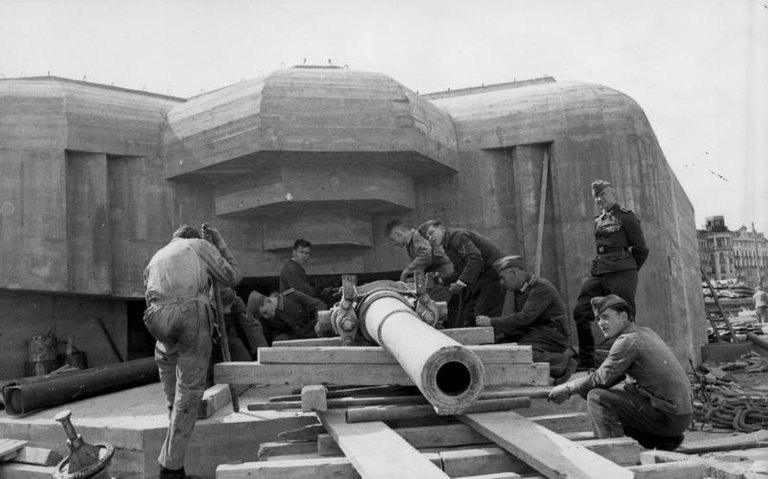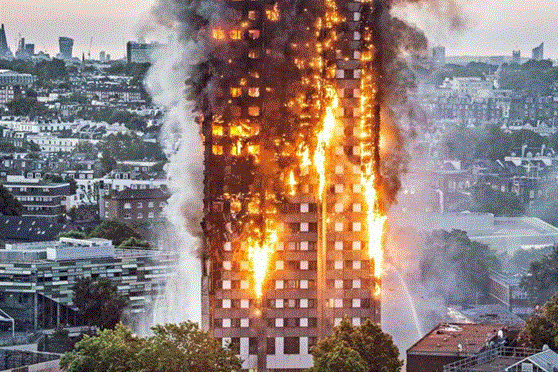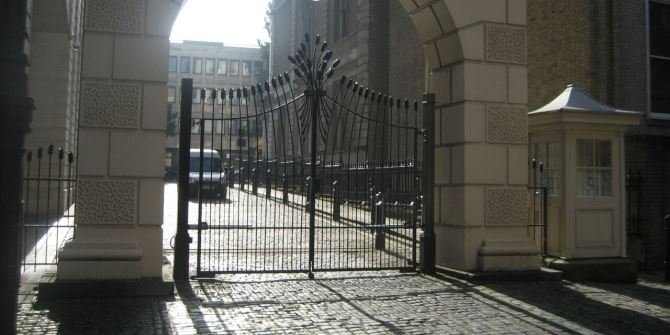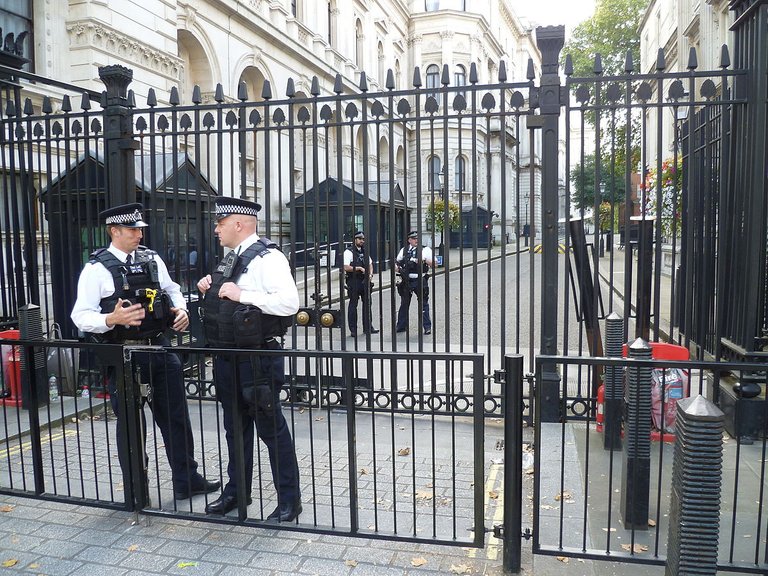
In his book 'The Architecture of Happiness' philosopher Alain De Botton explores the psychological ways in which the spaces that surround us elicit different feelings and support certain behaviour patterns. However, his book does not (presumably because it is taboo) explore the ways in which architecture supports and reflects the dominant, predatory, patriarchal themes of our modern societies.
Every dominant political movement has its own architectural preferences, perhaps none so overt as that of the Nazis, explored here by Jonathan Meades in this excellent and funny documentary:
In short, the Nazis built structures that faciliated their activities: From grand auditoriums like the Sportpalast in Berlin for dictatorial speeches; to the gas chambers for the holocaust. In their new forms, modern Nazis continue to create structures that support their aims.
Dominant ideologies shape architecture
If we broadly agree with this idea: That dominant ideologies will shape and craft the architecture of social spaces; the logical question seems to be: In what ways has our current political system, one of male dominance, the epidemic abuse of children and sexual predatation, shaped the architecture of our spaces? Given that more than 1 in 3 women and 1 in 5 men have been sexually abused, in what ways does the architecture of our modern societies facilitate and support the perpetration of these abuses?
Architecture as Abuse
In its most simple form, the architecture of abuse relies on walls and doors. Both these structures can contain children or adults for the purpose of abuse. Then, other walls and doors, subsequently, protect these abusers from public outrage at their crimes.
To return to an overt example before looking at the covert examples in our present day: The Nazis built concentration camps with perimeter fences and armed guards to keep prisoners inside:

Yet the construction of these abusive compounds necessitated similar-looking compounds to protect the abusers from the consequences of their actions. In other words: For every architectural Yin of abuse; a Yang of self-defence agains the consequences of that abuse is required. And so we get Nazi fortifications like this, which protect the architects of the camps from the consequences of their action. Both are camps. One in which people are abused; the other in which the abuser is protected from consequence:

We can see the same pattern played out today. The foreign policy of the Western World, for example, creates concentration camps like this:

Which require corresponding defensive structures like this:

Again, the architecture of a Guantanamo Bay or Abu Ghraib allows abuse to be perpetrated. The architecture of the Pentagon and other so-called 'government' buildings then protects the abuser from the consequences of this abuse. Again, we see how the architectural structures of abuse require a corresponding fortification of the abuser's structure. Every prison-camp requires a corresponding fort. Now let's look at more subtle examples.
The Architecture of Power
Here is Grenfall tower, a structure that was designed to provide low-cost housing to those on a low income in London, UK:

This fire killed many people on account of the neglect of wealthy land owners. The British Government has always neglected to represent or support lower-income people. Instead, it has supported the ambitions and needs of those at the top of feudal hierarchy. So, it has been necessary for the abuser to build corresponding fortifications to enable covert massacres like this to continue. Look, for example, at the defensive architecture surrounding the residences of those who perpetrated this abuse:
Castles vs Farms
Traditionally, farms existed outside the castle walls. This feudal structure allowed the wealthy land-owner to defend his or her interests (usually his) above the interests of the 'common' people. This is true even of today. Here, we can see the architecture of a modern farm:

Or here:

And the corresponding architecture that protects those who run the farms. In other words, the 'castles' that the farms report to:

A rich, gated-community in central London
Rowland Atkinson, a Professor at the University of Sheffield, wrote of these rich Castle-owners that, "elaborate security systems, a supporting cast of staffers, and other services, enable a seamless engagement with space are all in place and emanate from the domestic realm. The ultimate goal of many buyers is a space that allows drive-in car parks with internal exits." In other words: The abuser need not in any way be in contact with the consequences of his abuse: He is architecturally insulated from the 'common people', and therefore his actions, through the design of the spaces he exists in.
It seems that the architecture of abuse always requires two components to function: Both walls and doors to keep the abused trapped inside; and also corresponding walls and doors to keep the abuser protected from the fallout of his exploitation of society.
In short: For every mansion, somewhere else there is a prison cell.

You explained every bit of it in interesting way and such a fascinating way to summarise things up thanks for sharing that
Thank you, @blazing. Glad you found it interesting :)
A fascinating study and killer last line. Thank you for this insight.
Writing this piece helped me to clarify my own thoughts.
I might write more on this topic soon. I am very interested in the way that space is used to control or free.Thank you @lenskonig.
I appreciate your efforts.
Great content and very well articulated. ☺Great article @matrjoschka.
please have a look at my post
Thanks for sharing this post.
Thank you for reading. And for your support. @stardivine
Keep it up.
I will definitely support you. ☺Pretty awesome article @matrjoschka. Nice video, very interesting. Very well summarised.
Thanks for sharing.
Upvoted & resteemed your post.
Glad you enjoyed the video :)Thank you, @arpitrathore
Thank you for these brilliant observations and linking of ideas, and for the fascinating art-history documentary on Nazi architecture which I have just finished watching (and chuckling away to).
It seems clear - to take just one strand of this - that abuse requires a lack of transparency in which to operate, whether behind closed doors or in broad daylight. Lack of transparency allows all sorts of manipulations to be enacted and fears to be triggered - games of Power and Control.
In a world of transparency - where everything is out in the open, it would not be as easy to deceive, nor would there be as much motivation to seek personal gain (psychological, financial, emotional etc) - there would likely be fewer such games played.
While this obviously looks a million miles away from where the world appears to be atm - ie full of victims and victimisers, I think the aspect of transparency is, and will continue to make a massive difference in lifting humanity out of this duality.
Take the trend of mass access to info, starting with the printing press, easier and cheaper access to material in the local vernacular, cutting out the middle-manipulator-interpreter, being able to read for oneself. What a massive shift, what a massive boost to empowerment and creativity for the collective human consciousness!
I think there is something of a similar, perhaps greater, magnitude taking place with the advent of the internet. It may be confusing for many who struggle under screeds of unfiltered data and do not feel able to discern Solid vs FUD, but I guess it wasn't until a while after the Gutenberg press started printing that enough people learned to read and creativity and new ideas began to spread in a big way, filtering up through the 'early adopters' and into mass acceptance and way of life.
Which leads me to the point of my point :) - the transparency of the blockchain as a living metaphor for the above stated analogy. I like and welcome the level of transparency on steemit. I should say that by 'transparency', I am not talking about every single itsy-bitsy detail being public, for there is always a private domain for the individual being (which does not violate any other being). I think of transparency as 'clarity' - I am clear about why I do things, and this is clear to others who observe or interact with me. If I am unclear about something, this is clear, and it can be cleared-up lol. I think Steemit works in this manner eg account figures and behavioural patters available to anyone.
Hmm, I'm out of thought now. On re-reading this, the point I'm making isn't really a very strong one, but I've written a fair bit and this is a month old post - an excellent one :D - so I'll just leave it here, as anything else is beginning to sound BS. Train of thought worked only to a point I guess. I am optimistic in this regard though!
🚣Anyway, nice to meet you @matrjoschka 🔆
Thanks for your interesting thoughts :) Yes, I agree that transparency is important; hopefully our future will be designed around systems that have public accountability. I think the monetary system lays the foundation for so many other corruptions and I'm enjoying our rapid switch to crypto.Hi @barge,
I'm with you on the Gutenberg press theory. I also feel that what we might be witnessing at the moment is people's disenchantment with authority and (hopefully) a migration towards an understanding of the world that relies on self-education and knowledge instead of accepting information based on the prescribed authority of a source: Government; the media; etc.
Now that we know that most mainstream sources of information are corrupt; we have the opportunity as individuals to personally investigate all knowledge that was imposed upon us rather that arrived at through personal experience.
Interesting times!
Hi ,
Nice post , check my crypto blog aswell @lightreflections !
Thank you, @lightreflections